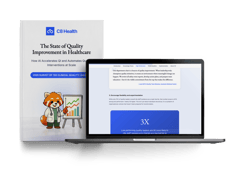
8 Best Practices for Safe Medication Administration
Medication errors are a significant concern within the healthcare industry, posing risks to patient safety and adding to the already complex challenges healthcare providers face. These errors can occur at any point in the medication process, from jotting down a prescription to handing out the pills. That's why it's essential to recognize the key contributing factors to these errors and implement comprehensive strategies to mitigate them. Below, we explore these factors and provide best practices to significantly reduce medication errors in healthcare settings.
» Make your organization's knowledge accessible to everyone on the team with this solution.
Meet the Expert
Leah Alexander, an experienced general pediatrician, has 23 years of practice, specializing in caring for patients from infants to 21 years.
8 Best Practices to Administer Medication Safely
- Prioritize patient safety over speed
- Use correct medication labeling
- Cross-check patient info
- Properly educate patients
- Incorporate double-check procedures
- Apply strict protocols for high-alert medications
- Leverage technology
- Establish a robust training and development program
1. Prioritize Patient Safety Over Speed
Doctors play a pivotal role in medication management, and errors often arise from various aspects of their practice. Here's what to watch out for:
- Time Constraints and Rushed Prescriptions
In a healthcare environment where physicians are inundated with patients and have limited time for each consultation, the pressure to manage time efficiently can lead to rushed prescription processes. - Electronic Prescribing Systems
While electronic prescribing systems have certainly improved accuracy, they're not without their challenges. Certain systems may have limitations when conveying specific prescription details, potentially leading to errors. - Incomplete Patient Information
In pediatric medicine, for instance, medication dosages are often weight-based. If there's no updated weight on record, or if the staff doesn't have time to measure it accurately, it can result in an incorrect prescription. - Illegible Handwriting
Although handwritten prescriptions have become increasingly rare in modern healthcare, physicians' handwriting is notoriously difficult to decipher, potentially leading to misinterpretation by pharmacists.
The solution? Take your time and put patient safety above speed. Verify patient info, check allergies, and go over prescription details carefully. A slow, steady approach to prescribing can significantly reduce errors and improve patient outcomes.
» Want to easily access vetted medication guidance? Check out C8 Health
2. Use Correct Medication Labeling
Medication labeling is a critical factor in preventing errors during medication administration, especially in high-stress environments like anesthesia and acute care. These errors often occur because labels appear similar or the wrong label is simply placed on the wrong medication. To mitigate this, healthcare institutions implement color coding systems, where specific colors are assigned to different drug classes (e.g., blue for opioids, yellow for hypnotics). This standardized approach makes it easier to quickly and accurately identify medications.
C8 Health's platform has a compendium feature that displays customized drug dosages with their relevant color code, vetted by your institution. This ensures clinicians adhere to their institution's medication guidelines.
3. Cross-Check Patient Info
Pharmacies are the gatekeepers of medication distribution, but they, too, can be susceptible to errors. Some of the most common blunders include:
- Dispensing the wrong medication: Despite their crucial role, pharmacies may occasionally dispense the incorrect medication, posing serious risks to patients.
- Medication substitution: Pharmacists sometimes substitute prescribed medications with cheaper alternatives that might not work the same way.
The goal should be for pharmacists to meticulously verify patient information and communicate with healthcare providers about any substitutions or concerns. Ensuring that patients receive the medication as prescribed is paramount to their safety and well-being.
4. Properly Educate Patients
Ideally, healthcare providers should educate patients about the importance of adhering to their prescribed medication regimen and provide any necessary counseling to address potential side effects or drug interactions. Failure to do this may lead to:
- Misadministration: Patients or their caregivers may misunderstand or misinterpret instructions on how to administer medications correctly, leading to dosage errors.
Healthcare providers should take time to educate patients thoroughly. Provide clear, written instructions and encourage open communication to address any questions or concerns about their medications. Regular check-ins can help catch mistakes too.
5. Incorporate Double-Check Procedures
Double-checking procedures are pivotal in catching errors before they reach the patient. Failure to do so can lead to management oversight, which can result in serious consequences for both the patient and the healthcare provider, including medical malpractice lawsuits, loss of reputation, and potential harm to the patient's health or well-being.
This is where robust double-check systems for medication dispensing and administration come in. Ideally, a senior staff member or manager should independently verify medication orders, particularly for high-risk medications. You should also ensure that multiple professionals review and verify medication orders, creating an additional layer of safety.
6. Apply Strict Protocols for High-Alert Medications
High-alert medications demand extra caution due to their potential for harm. That's why healthcare providers should be extra careful when prescribing controlled substances. Assess the patient's needs, prescribe small amounts, and provide crystal-clear instructions.
It's also crucial to educate patients comprehensively about the risks and benefits, closely monitor their usage, and maintain meticulous records of their prescriptions.
7. Leverage Technology
Modern technology plays a significant role in preventing medication errors and enhancing patient safety. Beyond managing patient data, it also facilitates streamlined access to updated medical guidance and promotes coordinated care.
Recent incidents, like those documented on medication errors in two California hospitals, underscore the critical need to harness technology for medication safety. Core issues that surfaced include:
- Not following hospital protocol
- Duplicate prescription fulfilling
- Incorrect doses of medications
These issues occurred because staff either didn't communicate with each other, didn't follow the proper protocols, or didn't have access to updated information.
To adhere to best practices in medication administration, healthcare providers must embrace these technological solutions and ensure staff proficiency in their use. This approach not only reduces the risk of medication errors but also leads to improved patient outcomes and a safer healthcare environment.
» Learn more about C8 Health's platform for guidance management and care collaboration
8. Establish a Robust Training and Development Program
Structured training programs are fundamental for healthcare facilities, particularly when it comes to new hires. Healthcare facilities should deliver comprehensive training to newly hired staff members, including orientation and ongoing education. It's also important to regularly evaluate staff performance and offer re-training as needed to address knowledge or skill gaps.
The training and development program should cater to different learning needs and experience levels. You should also encourage continuous learning and improvement among your healthcare staff.
» Want to streamline your organization's education? Start here.
Safe Medication Administration: It's a Group Effort
Preventing medication errors is a shared responsibility among healthcare providers, pharmacists, patients, and healthcare facilities. Most importantly, healthcare providers should strive to stick to these best practices and always put patient safety first. Through a collective effort, the healthcare industry can move closer to achieving error-free medication management. C8 Health aims to promote smoother medical collaboration and put life-saving knowledge at the fingertips of healthcare providers.


